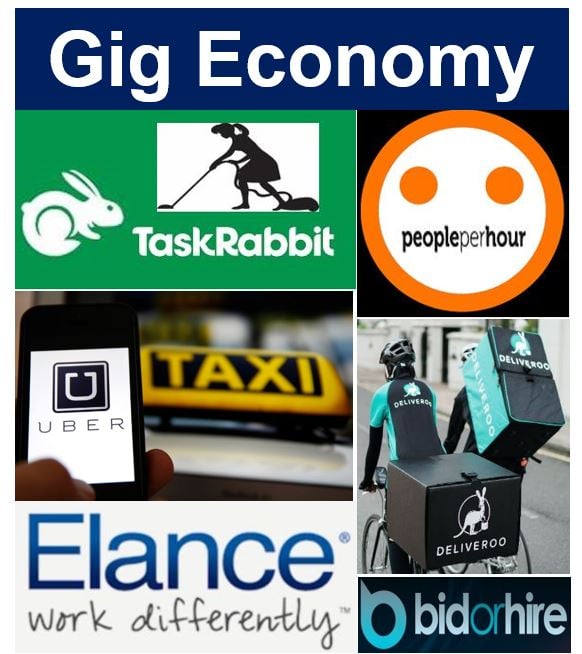A Gig Economy is one where companies hire independent contractors and freelancers instead of taking on full-time workers. In a gig economy, temporary positions are common, but full-time permanent ones are not.
The gig economy is becoming an increasingly common feature in most countries across the world today. It emphasizes flexibility for both employers and workers, differing from the stability and predictability of the traditional workforce.
The gig economy contrasts sharply with the traditional economy, which consists of full-time workers who focus on a lifetime career and rarely change positions.
The COVID-19 pandemic accelerated the growth of remote freelance work and delivery gigs, but also highlighted systemic vulnerabilities. Many workers in the gig economy need to do their gig work to meet basic needs, however, lots lack health coverage or paid sick leave. They are also more likely to experience income volatility compared to traditional employees.

Gig economy is flexible
For a gig economy to work, you need a large number of people who are willing to work in temporary positions or part-time. The result is an economy that is more flexible and offers cheaper services – such as Airbnb or Uber – for consumers willing to use them.
The benefits of the gig economy are lost to people who do not utilize technological services such as the Internet. Cities, which are the most entrenched in this type of economy, tend to have the most highly-developed services.
One of the drawbacks of the gig economy for the full-time employees who still exist, is that it is much more difficult for them to fully develop their careers. This is because there are so many cheaper and more flexible temporary employees available in the job market.
In the United States, virtually all sectors have drifted away from employing full-time, permanent staff, and embraced the flexible, part-time or temporary gig worker. Universities today are hiring more part-time and adjunct professors instead of offering tenured positions.
Adjunct professors are hired by colleges on a contractual part-time basis. With ever-tightening budgets, the role of the adjunct professor is expanding rapidly in education in the US and many other countries.
The gig and the gig economy
In an article in the Bureau of Labor Statistics, part of the United States Department of Labor, Elka Torpey and Andrew Hogan quote Ryan Heenan, a songwriter who sells jingles and customized videos to clients across the world.
Torpey says:
“It’s really a dream come true,” says Heenan. “It gives me the freedom to set my own hours. And I can do what I do anywhere there’s an Internet connection.”
According to the authors, the terms ‘gig’ and ‘gig economy’ have no official definition. They describe a gig as a single task or project for which a worker is hired, usually through the digital marketplace, to work on demand.
Gig apps and websites
Many gigs are a kind of short-term job, and some workers seek out gigs as a self-employment option – these concepts are not new. However, a more recent development is employers connecting workers with these jobs via websites or mobile apps.
Gig workers exist across diverse occupation groups. They are not easy to identify in employment and earnings surveys. However, they all have one thing in common – how they earn money.
They usually get individual gigs using a mobile app or website that helps them match with clients. A gig can last from eighteen months to literally a matter of minutes, such as answering a survey.
In a gig economy, workers who try to earn a steady income through short-term contracts have to find another gig as soon as their current one is completed. This sometimes means juggling several jobs at the same time.
New forms of gig work are emerging in the age of AI. Platforms offer workers tasks such as labelling images, moderating content, or reviewing AI outputs. These gigs are often low-paid and repetitive, raising ethical concerns around “ghost work” and digital exploitation.
Workers in the gig economy
The United States
The US Bureau of Labor Statistics says it has data on gig workers dating back over ten years.
As of July 2023, the US Bureau of Labor Statistics reported that independent contractors comprised 7.4% of total employment ( approximately 11.9 million people). This marks an increase from 6.9% in May 2017.
Other Bureau data suggest a sharp slant towards a gig economy in the United States. However, the workers in these recent data are not broken out separately.
For example, gig workers may be included in worker-counts that include part-timers, self-employed individuals, or those holding multiple jobs. However, these counts also include employees who are not part of the gig workforce.
Laws governing gig work are evolving. California’s AB5 law, which wanted to reclassify gig workers as employees, sparked fierce debate. In response, Proposition 22 (passed in 2020) allowed companies like Uber and Lyft to continue treating drivers as independent contractors.
📊 The Gig Economy in 2024
Based on the TransUnion Fall 2024 U.S. Gig Economy Report
🧍♂️ Participation
- 62% of US adults earn money on gig platforms
- 37% say it’s their primary income
- Millennials: 78%, Gen Z: 67%
- Gen X: 65%, Boomers: 36%
💵 Earnings
- 2/3 earn under $2,500/month
- 36% of Millennials earn $5,000+
- 21% of Gen Z earn $5,000+
😊 Worker Satisfaction
- Flexibility – 71%
- Enjoy the work – 59%
- Skillset fit – 47%
- Earning potential – 41%
📈 Future Plans
- 35% of Gen Z plan to increase hours/platforms
- 31% of Millennials plan to increase gig work
- Only 8% plan to leave for full-time jobs
💬 Motivation & Legitimacy
🫂 25% started due to a friend/family referral
🧠 Gig work is increasingly seen as a legitimate career
🔐 What Workers Want
- 🛡️ Identity protection
- 📘 Financial education
- 🏥 Supplementary insurance coverage
📅 Seasonality & Habits
45% of gig workers work year-round. Younger workers spike activity in summer/winter; older workers tend to work as-needed.
The United Kingdom
As of 2023, approximately 4.4 million people in the UK were engaged in gig work, representing nearly 14% of the workforce. This is a significant increase from 2.3 million in 2016.
In February 2021, the UK Supreme Court ruled that Uber drivers should be classified as “workers” rather than independent contractors. This entitles them to benefits such as the national minimum wage and paid leave.
A recent study reported that the erosion of collective bargaining powers for workers ‘creates a downward economic spiral’. Wages are a crucial part of demand in the economy because they allow consumers to spend. In wage led economies like the UK, low wages undermine the whole economy.
Types of jobs in the gig economy
Some jobs are more commonly advertised as gigs than others. Jobs that involve a single task, such as writing a business plan, are ideal gig-type positions.
Any work in which people may be hired for on-demand tasks has the potential for gig employment. Examples include photographers, painters, construction workers, drivers, delivery personnel, graphic designers, web developers, musicians, craft and fine artists, software developers, carpenters, technical writers, interpreters, translators, and computer programmers.
As of 2023, the US Bureau of Labor Statistics’ Occupational Outlook Handbook provides information on over 800 occupations, offering comprehensive coverage of the American workforce.
Gig economy – pros and cons
People who focus on gig work may do a variety of tasks, but they have similar things that they like – and don’t like – about their arrangements and lifestyles.
The following list includes the ‘Pros’ for workers:
- Control: Gig workers say it is nice to be in control and to be able to choose just the projects that you enjoy.
- Lifestyle: you can schedule your work around your personal commitments.
- Freedom: you can work when you like (presumably if there is work available). You can take a vacation whenever you like.
- Variety: in a gig economy workers get to do lots of different things. Life is rarely boring.
The following list includes the ‘Cons’ for workers:
- Uncertainty: to get consistent pay you will need to have a steady stream of jobs.
- Availability: sometimes there are not enough gigs available to provide a stable income.
- Planning: it is more difficult to plan ahead. If you are not sure how much you will be earning in future, taking on long-term commitments, such as mortgages, is more difficult.
- Control is a Myth: if you spend all your time trying to make sure you have enough gigs for a steady income, you are not in control of your life at all, many gig workers say.
- Lifestyle: many gig workers say they have to work non-standard days or times to finish a job. This contradicts those in the Pro camp who say lifestyle is a benefit.
- Lack of Benefits: gig workers do not usually get benefits that are paid for by the employer, such as health insurance, contributions to retirement plans, annual leave, and sick leave.
